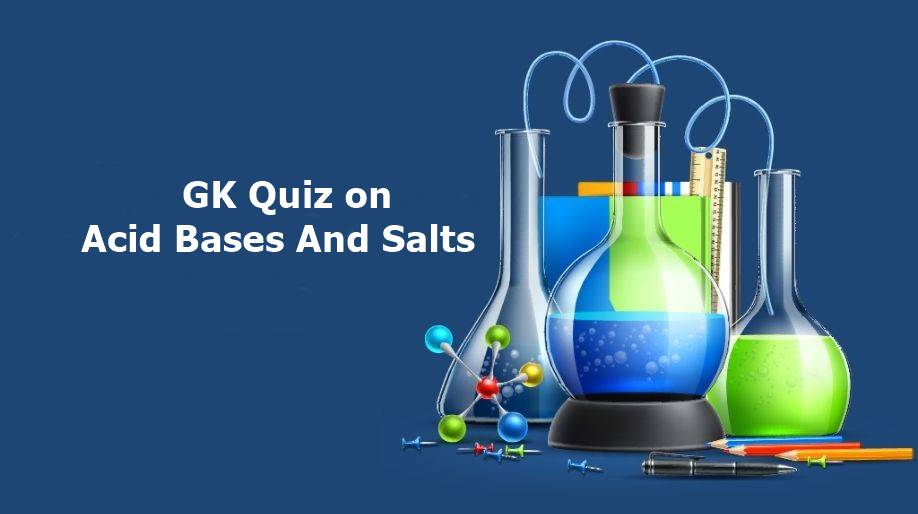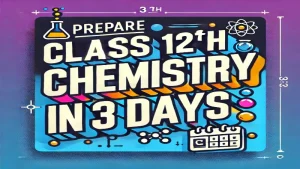CBSE Class 10 Science MCQs Chapter 2 Acids Bases and Salts with answers are available for free downloading. Practice these Acids Bases and Salts MCQs.
Acids Bases and Salts MCQs
Free PDF Download of CBSE Class 10 Science Chapter 2 Acids Bases and Salts Multiple Choice Questions with Answers. MCQ Questions for Class 10 Science with Answers was Prepared Based on Latest Exam Pattern. Students can solve NCERT Class 10 Science Acids Bases and Salts Multiple Choice Questions with Answers to know their preparation level.
Q1. Which Acid is present in Tomato?
A) Citric Acid
(B) Oxalic Acid
(C) Lactic Acid
(D) Hydrochloric Acid
Show Answer
Correct Answer: Option (B) Tomato contains more than 10 types of acids such as citric acid, malic acid, ascorbic acid, and oxalic acid etc
List of Acid present in food items
- Citric Acid Citrus fruits- lemon, Orange, Grapefruit
- Tartaric Acid Tamarind, Grapes, Pineapples, Potatoes, Carrots
- Acetic Acid Vinegar
- Oxalic Acid Pepper, Spinach, Tomato
- Tannic Acid Tea
- Caffeotannic Acid Coffee
- Benzoic acid Cranberries, prunes and plums,
- Malic Acid Apple, Ripe Bananas, Bananas, pomegranates, grapes, berries, tomatoes, and broccoli
- Lactic acid: Milk, Curd, Cheese
- Butyric acid and Caproic acid Butter
- Glutamic acid Onion
- Palmitic acid and oleic acid– Ghee
- Carbonic acid- Soda Water (Carbonated Beverages)
- Phosphoric acid: Soft drinks (Fruit)
- Caprylic acid and Palmitic acid– Coconut oil
- Arachidic acid Ground nut oil
- Oleic acid Olive oil
- Erucic acid Mustard oil
- Lauric acid Coconut milk
- Linoleic acid (55%) Soybean oil
- Myristic acid Coconut oil
- Pantothenic acid Chicken, Eggs, Mushrooms, Avocado
- Folic Acid Asparagus, Brussels sprouts, Spinach, Lettuce.
- Ascorbic Acid Amla, Gooseberry, Guava
- 1. Bananas Malic
- 2. Kiwifruit Citric
- 3. Limes Citric, malic, tartaric and oxalic acids
- 4. Lemons Citric, malic, tartaric and oxalic acids
- 5. Apples Malic, Succinic acids
- 6. Apricots Malic and Citric acids
- 7. Avocados Tartaric Acid
- 8. Grapefruit Citric, tartaric, malic and oxalic acids
- 9. Grapes Malic and tartaric, citric and oxalic acids.
- 10. Kumquat Citric
- 11. Loganberry Malic, citric acids
- 12. Nectarine Malic
- 13. Orange Peel Malic, citric and oxalic acids
- 14. Orange Citric, malic and oxalic acids
- 15. Passionfruit malic
- 16. Peaches Malic and citric acids
- 17. Pears Malic, citric, tartaric and oxalic acids
- 18. Pineapples Citric and malic acids
- 19. Plums Malic, tartaric and oxalic acids
- 20. Raspberry Citric
- 21. Rosehip Malic
- 22. Quinces Malic acid
- 23. Salad Citric and malic
- 24. Strawberries Citric, malic, shikimic, succinic acids
- 25. Tangerine Citric
- 26. Youngberries Citric, malic and Isocitric acids
- 27. Bilberry Citric acid
- 28. Blackberries Malic and Quinic acids
- 29. Blueberries Citric, Malic, Citramalic, quinic, glutamic and aspartic acids
- 30. Boysenberries Citric, malic, and Isocitric acids.
- 31. Cherries Malic, Citric, Tartaric, Succinic
- 32. Crabapple Malic
- 33. Cranberries Citric, malic and benzoic acids.
- 34. Currants Citric, tartaric, malic and succinic acids
- 35. Elderberries Citric, malic, shikimic and quinic acids
- 36. Figs Citric, malic and acetic acids
- 37. Gooseberries Citric, malic, shikimic and quinic acids
Q2. Which of the following is a strong acid?
(A) HCl pH 1
(B) CH3COOH pH 5
(C) Lemon juice pH 2.2
(D) Pure Milk pH 6
Show Answer
Correct Answer: Option (A) LOWER VALUE
Q3. Na2CO3.10H2O is known as –
(A) Baking soda
(B) Baking powder
(C) Washing soda
(D) Bleaching powder
Show Answer
Correct Answer: Option (C)
some examples of chemicals in everyday life
1 Baking powder NaHCO3; sodium bicarbonate Used for baking for cooking, releases CO2 in reaction with other ingredients
2 Soap Esters Used for bathing and washing clothes
3 Detergent Sodium sulphate, sodium hydroxide and phosphatecompounds Used for washing clothes
4 Toothpaste Calciuym carbonate, sodium flouride Used for cleaning teeth while brushing
5 Salt NaCl; Sodium Chloride Used in seasoning for cooking; also used as preservative
6 Vinegar C2H4O2
acetic acid, ethanoic acid Used as preservative and for seasoning foods. Utilized for various household cleaning uses.
7 Graphite Carbon Used in Pencil
8 Alcohol Ethanol(C2H6O) Used in alcoholic drinks
9 Bleaching Powder NaOCl Commonly used domestic bleach. Used for cleaning purposes
10 Sugar Sucrose; C12H22O11 Used in cooking as sweetner
11 Aspirin C9H8O4; acetyl salicylic acid Used in various medicines
12 Mouthwash H2O2; hydrogen peroxide, Used for personal hygiene.
13 Caustic soda NaOH; sodium hydroxide It’s a highly corrosive alkali which is used for cleaning, unblocking sinks, drains and toilets.
14 Moth balls C6H4Cl2; 1,4-dichlorobenzene Has a strong pungent smell and is used to kill clothes moths and fabric pests.
15 Chalk CaCO3; calcium carbonate Uses incl. blackboard chalk, pavement (or, in USA, “sidewalk”) chalk, gymnastics and rock-climbing, and sometimes in toothpaste.
16 Insect repellent (application on skin) Diethyltoluamide Protects from different bug bites
17 Hand sanitizer IPA: Isopropyl Alcohol Kills germs
18 Rat poison Arsenic Use to wipe out rats in household
19 Toilet cleaner HCl: Hydrochloric acid Cleaning toilet bowls
20 Whitener Sodium hypochlorite(liq) Whitening agent for clothes
21 Antiperspirant & Deodorants Al2ClH7O6: Aluminum chlorohydrate Controls body odor
22 Diamond Carbon Used in jewelry
23 Epsom salt MgSO₄: Magnesium sulfate Bath salt used to relieve muscle sores
24 MSG C₅H₈NO₄Na: Monosodium glutamate Flavor enhancer
25 Marble CaCO3: Calcium carbonate Used as Flooring
26 Sand SiO2: Silicon Dioxide Construction, sustainable container etc
Q4. pH value higher than 7 indicates that the solution is –
(A) Acidic
(B) Basic
(C) Neutral
(D) No effect
Show Answer
Correct Answer: Option (B)
Q5. Which of the following is neutral salt?
(A) NH4Cl
(B) CH3COONH4
(C) CH3COONa
(D)Na2CO3
Show Answer
Correct Answer: Option (B)
A neutral salt is a salt that has no acidic or alkaline properties and a pH of 7. Neutral salts are formed when
- a strong acid reacts with a strong base
- a weak acid reacts with a weak base
Acidic salts: Formed from a strong acid and a weak base, with a pH of less than 7. Examples include ammonium chloride (NH4Cl) and sodium bisulfate (NaHSO4).
Basic salts: Formed from a strong base and a weak acid, with a pH of greater than 7. Examples include sodium carbonate (Na2CO3) and sodium acetate (CH3COONa).
Neutral salts: some examples of neutral salts: Sodium chloride (NaCl), Sodium nitrate (NaNO3), Potassium sulfate (K2SO4), and Potassium chloride (KCl).
Q6. Lactic Acid is present in –
(A) Orange
(B) Tea
(C) Milk
(D) Vinegar
Show Answer
Correct Answer: Option (C)
Lactic acid is found primarily in sour milk products, such as kumis, laban, yogurt, kefir, fermented milk and some cottage cheeses.
Q7. Farmers neutralise the effect of Acidity on the soil by adding –
(A) Slaked lime
(B) Gypsum
(C) Caustic soda
(D) Baking soda
Show Answer
Correct Answer: Option (A)
- converting the acidic soil into neutral soil, a small quantity of quicklime or slaked lime solution is added.
- on the other hand Farmers add acidic substances to neutralize the effect of basicity on soil, such as manure, compost, elemental sulfur, aluminum sulfate, or sulfuric acid
Q8. CuSO4.5H2O: In this Compound, the water molecule is called –
(A) Pure water
(B) Water of crystallization
(C) Soda water
(D) None of these
Show Answer
Correct Answer: Option (B)
water of crystalization or hydrated water
Q9. Which of the following salts does not contain water of crystallisation?
(A) Blue vitriol
(B) Baking soda
(C) Washing soda
(D) Gypsum
Show Answer
Correct Answer: Option (B)
Water of Crystallization Examples
- Washing Soda (Na2CO3.10H2O)
- Gloubers salts (Na2sO4.10H2O)
- CuSO4.5H2O (Copper sulfate Penta hydrate) Blue vitriol
- FeSO4.7H2O (Ferrous sulfate heptahydrate) Green vitriol.
- Gypsum (CaSO4.2H2O)
- Tin (II) Chloride Dihydrate (SnCl2.2H2O)
- Epsom salt is MgSO4·7H2O
- White vitriol is ZnSO4·7H2O
- Sodium borate- borax – Na2B4O7.10H2O
- POTASSIUM ALUM- KAl(SO₄)₂·12H₂O
- plaster of Paris is CaSO4.1/2H2O
- CaSO4.2H2O is the chemical formula for gypsum
Q10. In which pH range does our body work to survive in the atmosphere?
(A) 5.5 to 8.5
(B) 7.0 to 7.5
(C) 2.3 to 7.0
(D) 7.6 to 8.5
Show Answer
Correct Answer: Option (B)
Q11. In terms of acidic strength, which one of the following is in the correct increasing order?
(a) Water < Acetic acid < Hydrochloric acid
(b) Water < Hydrochloric acid < Acetic acid
(c) Acetic acid < Water < Hydrochloric acid
(d) Hydrochloric acid < Water < Acetic acid
Show Answer
Correct Answer: Option (A)
Q12. What is formed when zinc reacts with sodium hydroxide?
(a) Zinc hydroxide and sodium
(b) Sodium zincate and hydrogen gas
(c) Sodium zinc-oxide and hydrogen gas
(d) Sodium zincate and water
Show Answer
Correct Answer: Option (B)
Explaination: Reason: Zn + 2NaOH → Ma2Zn02 (Sodium Zincate) + H2
Q13. Brine is an
(a) aqueous solution of sodium hydroxide
(b) aqueous solution of sodium carbonate
(c) aqueous solution of sodium chloride
(d) aqueous solution of sodium bicarbonate
Show Answer
Correct Answer: Option (C)
Q14. At what temperature is gypsum heated to form Plaster of Paris?
(a) 90°C
(b) 100°C
(c) 110°C
(d) 120°C
Show Answer
Correct Answer: Option (B)
Q15. Sodium carbonate is a basic salt because it is a salt of a
(a) strong acid and strong base
(b) weak acid and weak base
(c) strong acid and weak base
(d) weak acid and strong base
Show Answer
Correct Answer: Option (C)









I want more MCQ like this